CTV NEWSCHANNEL: ony Hale about his role as ‘Forky’ in “Toy Story 4.”
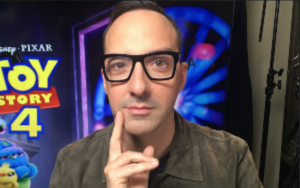 Richard and “Toy Story 4” actor Tony Hale discuss his character’s existential crisis and what message “Forky” sends to kids.
Richard and “Toy Story 4” actor Tony Hale discuss his character’s existential crisis and what message “Forky” sends to kids.
Watch the whole thing HERE!
 Richard and “Toy Story 4” actor Tony Hale discuss his character’s existential crisis and what message “Forky” sends to kids.
Richard and “Toy Story 4” actor Tony Hale discuss his character’s existential crisis and what message “Forky” sends to kids.
Watch the whole thing HERE!
“Toy Story 3” seemed like the end of the line for Woody, Buzz Lightyear and Company. Andy, the young boy who loved and cared for them (just as much as they loved and cared for him) put away childish things and headed off for college, leaving his toys on the curb. As it turns out the end of their time with Andy was the beginning of a new life with spunky five-year-old Bonnie (Madeleine McGraw).
These days Woody (Tom Hanks), the gangly pull-string cowboy doll who was Andy’s favourite, sits, unloved and unused in Bonnie’s closet. He may be gathering dust bunnies but he takes his job very seriously. Woody passionately believes that he and the other toys play a crucial part in the upbringing of their child, so when it comes time for Bonnie to go to orientation day at kindergarten he tags along. When a boy bullies her, taking away her arts-and-craft supplies, Woody leaps into action, rescuing some crayons and odds and ends from the garbage for her. Brushing aside her tears she makes a toy out of a spork, a pipe cleaner, some googly eyes and a wooden ice cream spoon. She names it Forky (Tony Hale) and soon they are inseparable. Trouble is, Forky is in the midst of an existential crisis. ”I am not a toy,” he says, “I belong in the trash.” When Forky gets loose during a family road trip, Woody sees it as his duty to track him down and return him to Bonnie. With the help of pals Space Ranger Buzz Lightyear (Tim Allen), cowgirl Jessie (Joan Cusack), goofy T-Rex (Wallace Shawn) and others including a doll with a broken voice box (Christina Hendricks), Woody goes on an adventure and learns what it really means to be a toy.
Like the other entries in the “Toy Story” franchise, “4” doubles down on themes that other recent kid’s films have taken pains to avoid. Loss, moving on, unrequited love (yup, toys can fall in love) and good vs evil sit alongside the more traditional leitmotifs of friendship and loyalty. The movie can’t really be described as dark, although the ventriloquist dummies are the stuff of nightmares, but it has a level of emotional maturity that is part of Pixar’s trademark.
Part of that is likely due to the investment we have in these characters. Adult members of the audience have been watching these films for twenty-five years, literally growing up with Woody and Buzz and the kindly voicework that comes along with them, particularly from Hanks whose voice has the same effect as a cuddly warm blanket. As animated characters they are free to explore deeper emotional troughs, I think, because they look like toys. If this wasn’t animated, if the characters weren’t made of rubber and plastic, their travails may not be lessened but they might be less palatable for kids.
The main story focusses on Woody and his self-realization but he’s supported by a raft of new characters. Keanu Reeves plays Duke Caboom, a small plastic motorcycle daredevil from Canada (Who’s the Canuck with all the luck? Who’s the greatest of the Great White North?). He’s heroic in his own way, a wannabe champion with a funny and (here’s that word again) poignant backstory.
Forky’s journey is McGuffin that drives the plot forward. The story isn’t really about him but his search for purpose is a good fit for the “Toy Story” universe. Hale’s voicework brings a fun sense of confusion—Forky is a Frankenstein character, a child discovering the world—that keeps his character interesting and amusing.
Best of all is Hendricks as Gabby Gabby, the vintage doll who was “defective out of the box.” She has the widest arc of any of the characters, (MILD SPOILER) from villainous to sympathetic, and the tone of Hendricks’ voice is both menacing and doll-like.
“Toy Story 4” doesn’t feel like a classic in the same way the original did (and still does) but the laughs and the heart-tugging moments feel earned because Pixar place story and character ahead of the frenetic action so often showcased in other films for children. It is essentially an action/adventure movie, less complex than “1,” “2” and “3,” but there is an undeniable poignancy and yes, adult fans may even shed a tear or two as the long running story comes to a conclusion.
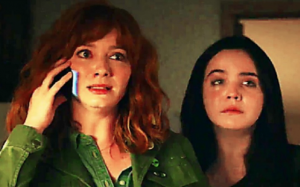 By Richard Crouse – Metro Canada
By Richard Crouse – Metro Canada
Christina Hendricks is thankful for a warm jacket. “I was shooting on a mountain only hours ago,” she says on the line from Calgary. “It is below zero but they are doing a great job of keeping me warm. Those parkas are no joke.”
The Knoxville, Tenn., native hasn’t called to talk about the weather in Canada, however. She’s on the phone to discuss her new film, the creepy killer flick The Strangers: Prey at Night.
The former Mad Men star plays a mother who moves her family to a remote community in an effort to put some distance between her daughter and the bad influences of the city. There’s no one around except for three masked psycho killers, Dollface, Man in the Mask and Pin-Up Girl who emerge from the woods with knives, axes and bad intentions.
The creep-fest is a sequel of sorts to The Strangers, a 2008 home invasion film that saw the masked marauders attack an unsuspecting family. It’s also one of Hendricks’ favourite movies.
“I am a huge, huge fan,” she says. “I’ve talked about it for years. I think it is the scariest movie I have ever seen in my life and I reference it all the time. It was coincidental that they came to me. My manager said, ‘I don’t know if you are interested in doing a horror film about The Strangers.’ And I screamed, ‘The Strangers! Are you kidding me?’”
She says the villains of The Strangers: Prey at Night unsettle her more than Dracula, Frankenstein or anything that goes bump in the night because there’s nothing supernatural about them. But at the same time there’s nothing natural about the horrors the all-too-human monsters unleash on the newcomers.
“It’s my absolute worst nightmare,” she says, “people messing with you just because. It’s not a devil thing. It’s not a monster thing. It is not an apocalypse. It is just people coming to mess with you because they can.”
The film was shot in rural Kentucky. “It is beautiful during the day but when the sun goes down it is scary,” she says. “Everything is scarier in the dark.
“I thought, ‘Certainly I won’t be that scared. I know what’s going on,’ but I was actually scared. In the moments before we had to get ourselves worked up so Bailee (Madison, who plays her daughter) and I would go off to a different area and gear ourselves up before they yelled action. You can’t turn it on immediately. You have to get yourself in that state but in between we got along so well. We listened to music and had a laugh.”
She says she enjoyed everyone on set but didn’t hang out with the entire cast.
“They did keep a little bit more separate,” she says of the actors playing the masked killers.
“In the beginning we even said, ‘Can we not see them in their masks until the last moment?’ because they are so scary. It is kind of hard to be chatting and hanging out and having a snack with Dollface and the next thing you know she says, ‘I’m just going to go over here and kill you!’ ‘OK! I’ll see you in a minute.’ A little mystery helps.”
Movies like “The Strangers: Prey at Night” unsettle me more than stories featuring Dracula, Frankenstein or anything other thing that goes bump in the night because there’s nothing supernatural going on. At the same time there’s nothing natural about the horrors unleashed by the all-too-human monsters of this film.
The story gets underway when parents Cindy (Christina Hendricks) and Mike (Martin Henderson) load their teens Kinsey (Bailee Madison) and Luke (Lewis Pullman) into the car, on the way to a new life. Leaving the city behind, they’re off to Gatlin Lake, a small community that empties out after Labour Day. The change is an attempt to separate Kinsey from the bad influences surrounding her in the city. You know Kinsey is a rebellious teen because she wears an off the shoulder Ramones T-shirt and smokes cigarettes.
Arriving at their new home, a deserted trailer park, the kids are immediately bored as the parents try and make the best of an uncomfortable situation. Things get lively when three masked psycho killers—Dollface (Emma Bellomy), Man in the Mask (Damian Maffei) and Pin-Up Girl (Lea Enslin)—emerge from the woods with knives, axes and bad intentions. From that point on this becomes a movie where people make terrible decisions and frequently scream, “Leave us alone!”
The spooky opening, complete with anxiety inducing music, a bit of murder and a title card claiming the tale you are about to see is “based on true events,” sets up the film’s uneasy atmosphere. However, the movie never gets to the point where it is actually scary. Instead, it is a queasy-making experience that stems from the idea of people doing awful things for no reason. It’s nihilism. Bad things just happen and that’s the creepy part. “Why are you doing this?” Kinsey shrieks. “Why not?” mumbles Dollface.
The jump scares are secondary to the notion of the ruthless faceless murderers. The family is generic, just victims waiting to be taken. The villains are the stars, even though their faces are covered and they barely speak. They’re not thrill killers. They don’t seem to take much pleasure in their work despite their penchant for listening to syrupy pop music and leaving a bloody happy face symbol at the scene of their crimes. They are primal evil, nothing more.
“The Strangers: Prey at Night” is one note. Summed up in one line it’s, “Unstoppable killers do dreadful things to wide-eyed victims.” Like the first film in this franchise—2008’s “The Strangers”—it’s tight, only 85 minutes long, and values suspense over gore but goes too heavy on the sadism.
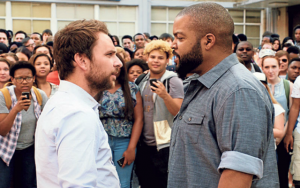 By Richard Crouse – Metro In Focus
By Richard Crouse – Metro In Focus
Fist Fight features so much bad language it completely outpaces f-word aficionados Tarantino and Scorsese combined. Accompanying the cussing are bad behaviour, violence and loads of oh-no-he-didn’t jokes all set against the backdrop of the end of semester at the rough-’n’-tumble Roosevelt High School.
Trying to hang on until the final bell rings are well-meaning English teacher Andy Campbell (Charlie Day) and Ron Strickland (Ice Cube), the world’s toughest history teacher. When Campbell accidentally gets Strickland fired a bad day goes from crappy to cruddy. “I’m going to fight you,” the amped-up Strickland says, looking for some street justice. “After school, meet me in the parking lot.”
As the #teacherfight spreads across social media, a crowd gathers in the parking lot to witness the carnage. After some hand-to-hand combat Campbell and Strickland come to terms with one another, learning important lessons with each punch.
My grade nine homeroom teacher Mrs. Armstrong wouldn’t recognize Roosevelt High as the kind of school she taught in, but it’s familiar territory for Hollywood, which has long used school hallways as a study of teen life. Relationships between students and teachers have fuelled movies like Blackboard Jungle and To Sir with Love, but just as interesting is the culture of the student body.
John Hughes mined the teenage dynamic for all it was worth in a series of classic teen operas like Sixteen Candles, but it’s The Breakfast Club that remains his most insightful look at high school life. The story is simple: five high school archetypes — the jock, the mean girl, the brainiac, the rebel and the outsider — thrown together during a nine-hour Saturday detention become unlikely friends, revealing their innermost secrets. “We’re all pretty bizarre,” says Andrew (Emilio Estevez). “Some of us are just better at hiding it, that’s all.”
It’s the emotional intensity of The Breakfast Club that makes it one of the most insightful high school films ever. Thirty-two years after its release it still feels fresh, but for my money one of the best looks at life in the halls comes from Emma Stone’s film Easy A.
The movie begins with the voiceover, “The rumours of my promiscuity have been greatly exaggerated.” It’s Olive (Stone), a clean-cut high school senior who tells a little white lie about losing her virginity. When the gossip mill gets a hold of the info, her life takes a parallel course to the heroine of the book she is studying in English class — The Scarlet Letter. At first she embraces her newfound notoriety; after all she had been all but invisible at the beginning of the school year. It isn’t until the lies and gossip start to spin out of control that she has to assert her virginity.
All the best high school movies — Election, Heathers, Dazed and Confused and Mean Girls — share that sentiment. The names, schools and places may change but it is the labours of students and teachers, like Fist Fight’s Andy Campbell and Ron Strickland, to find themselves and figure out what it all means that makes them interesting and relatable. As we learned studying Aristotle in philosophy class, “Knowing yourself is the beginning of all wisdom,” and, in Hollywood’s case, entertainment too.
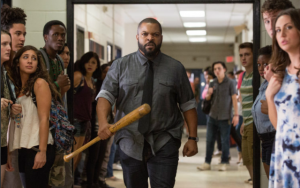 By Richard Crouse – Metro Canada
By Richard Crouse – Metro Canada
Director Richie Keen calls his debut film Fist Fight “a rated-R John Hughes film.”
The story of two teachers, played by Ice Cube and Charlie Day, who settle their differences in the schoolyard after the final bell is more rough ‘n’ tumble than anything the Sixteen Candles director ever attempted but Keen says he learned from Hughes’ habit of making sure the characters were true to themselves.
“John Hughes was one of my idols and he was so good at doing sweet moments. You’d see a movie and be laughing your ass off and then there’d be a real, sweet, great moment.
“I have my radar up that the heart, especially in this movie, comes from a very real character place. I feel like a very typical note that a director and writer might get is, ‘We need more heart.’ For me what they are really saying is that they are not connecting with the characters enough so I was very careful. It’s an R-rated comedy about two guys punching … each other a lot so I didn’t try and infuse false, sweet moments.”
Hughes’ influence dates back to childhood.
“I grew up in the ‘80s in suburban Chicago, in Highland Park, Illinois,” he says. “I just couldn’t believe they were making movies in and around my hometown. I was a little kid and John Hughes started coming into town. In Ferris Bueller there were some great scenes in my hometown. I would hop on my bike and I’d go watch them film. That’s how close it was happening. In high school it was Home Alone. I thought it was cool and this is going to sound strange but every time I was on or near a set I was like, ‘This is where I should be.’ It just lit me up in a way that other things didn’t.”
For years Keen made commercials, short films and was the house director on the hit TV comedy It’s Always Sunny in Philadelphia but says “I had no chance of getting this or any movie.”
After much cajoling he landed the Fist Fight gig, with just one proviso. He had to convince Ice Cube he was the man for the job. With just one day’s notice he flew to Atlanta to meet the Barbershop star.
“I had dressed in a nice outfit as my Jewish parents had taught me to do when you have a job interview,” he says. “I started drinking coffee and as time passed I started getting more jittery and more sweaty and by the time Ice Cube was waiting in the lobby I was in a T-shirt and sweaty.”
Intimidated by the rap legend — “The guy wrote No Vaseline,” he says. “It’s intimidating to meet him.” He pitched for 45 minutes, finally ending with, “‘Cube, are we doing this?’ Cube smiled and leaned back in his chair and thought for a second and said, ‘You know what? You flew out here at a moment’s notice. I love what you had to say. Let’s go make a movie motherBLEEPER.’”
The result is a raunchy movie with Ice Cube, some John Hughes-style heart and even some social commentary.
“I really wanted to shine a light on the public school system. Not to be heavy about it but I wanted to ground it in something.”
“Fist Fight” is a vulgar teen comedy, like “Porky’s” only with 1000% more jokes about penises, masturbation and sex. Then there’s the bad language that completely outpaces f-word aficionados Tarantino and Scorsese combined. Grandma won’t like this loose remake of the 1987 teen comedy “Three O’Clock High,” but anyone who’s ever dreamed of a raunchy version of “Revenge of the Nerds” should find a laugh or two here.
It’s the end of the semester at the rough-‘n-tumble Roosevelt High School, the kind of school where teachers complain the students are unteachable and the guidance counselor smokes crack to cope with the chaos. To compound matters, it’s Prank Day. That means strategically placed paint bombs, a horse, high on meth, roaming the halls and other mean spirited and dangerous hijinks.
Trying to get through the day are Andy Campbell (Charlie Day), a well-meaning English teacher and Ron Strickland (Ice Cube), the world’s toughest history teacher. Between the student shenanigans and budget cuts that threaten everyone’s jobs, tensions run high. When Campbell accidentally gets Strickland fired a bad day goes from crappy to craptastic. “I’m going to fight you,” says the amped up Strickland looking for some street justice. “After school meet me in the parking lot and we’ll handle this.”
The mild-mannered Campbell has never been in a fight but knows he can’t back down. As the #teacherfight spreads across social media a crowd gathers in the parking lot to witness the carnage. Before the fight begins, however, Campbell has a few things to take care of, including dancing with his daughter at a talent show.
“Fist Fight” is an anything-goes comedy that softens nears the end to deliver a few knockout punches on bullying, school budget cuts and doing the right thing. The messaging gets lost amid the mile-a-minute gags but its there if you squint your eyes and look very closely.
Not that the movie is much interested in anything but the laughs. It tries hard—almost too hard—to get a giggle out of the viewer, carpet bombing the audience with jokes, only about half of which land. Ten-year-old Alexa Nisenson nearly steals the show with a no-holds barred rendition of a Big Sean song. It’s wrong, completely wrong, but her message to a school bully is undeniable and joyful even if it turns the air at the junior high talent show blue. Also, it’s great to see Tracy Morgan back in action after his car accident.
Most of the heavy lifting lands on the backs of Day and Cube. It’s funny to hear Ice Cube seamlessly work in the title of his most famous song into a gag and Day brings a certain kind of Don Knotts charm to the role of the mild-mannered man who finds his inner gumption. They both deliver laughs, but many are of the oh-no-he-didn’t variety rather than deep belly laughs.
“Fist Fight” doesn’t lack punch, but many of the jokes feel like open handed slaps than direct hits.
How to describe director Nicolas Winding Refn’s “The Neon Demon”? You could use five dollar words like transgressive and hallucinatory. Or make comparisons to “Mulholland Drive” and “The Eyes of Laura Mars,” but none of that really comes close to capturing the nervy essence of what Refn attempts here.
Elle Fanning stars as the underage, somewhat naive model Jessie. An orphaned teen from a small town who’s been in Los Angeles “for like, a minute” scores a shoot with a hot shot photographer (Desmond Harrington). “She has that thing,” says her only friend, a makeup artist named Ruby (Jena Malone). Jessie’s fresh-faced appeal opens doors in the industry—Alessandro Nivola plays a big time designer who gives her the closing spot in his show even though its her first trip down a runway—but earns the ire of established models like Sarah and Gigi (Abbey Lee and Bella Heathcote) who she is replacing. “What does it feel like to walk into a room and it’s like the middle of winter and you’re the sun?” Sarah asks the new girl.
Refn, who also wrote the script, has pulled off something quite extraordinary here. He has made a movie that visually mirrors his subject. Setting the film in the vacuous world of fashion allows him to indulge his filmic sense while mirroring his visual ideas in the script. When the designer says, “True beauty is the highest currency we have,” he may have been talking about the fashion biz or Refn’s style of composing gorgeous images that accompany the film’s performances. I say accompany because there is a chilly disconnect between the story, which, true to its subject, is kind of hollow, and striking images on the screen. To reinforce that notion Refn even has a character say, “Beauty isn’t everything, it’s the only thing.”
A gutsy late movie turn toward necrophilia, horror and violence, while heart pounding and jarring, mostly draws the film even further away from any kind of traditional structure, although does graphically display how far people will go to capture the true essence of beauty.
“The Neon Demon” is a tone poem. The cast is terrific, especially Fanning in a role that requires steely determination and vulnerability, Keanu Reeves fans might get a kick out of seeing him go down ‘n dirty as a scummy motel manager and fans of “Mad Men” will enjoy seeing Christina Hendricks back at work, but this is a film more about feel than narrative and is the very definition of a “not for everyone” movie.
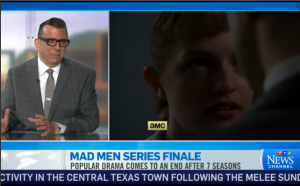 Did Don Draper finally find happiness? Richard and Marcia MacMillan and Richard Berthelsen discuss on CTV’s NewsChannel.
Did Don Draper finally find happiness? Richard and Marcia MacMillan and Richard Berthelsen discuss on CTV’s NewsChannel.
Watch the whole thing HERE!